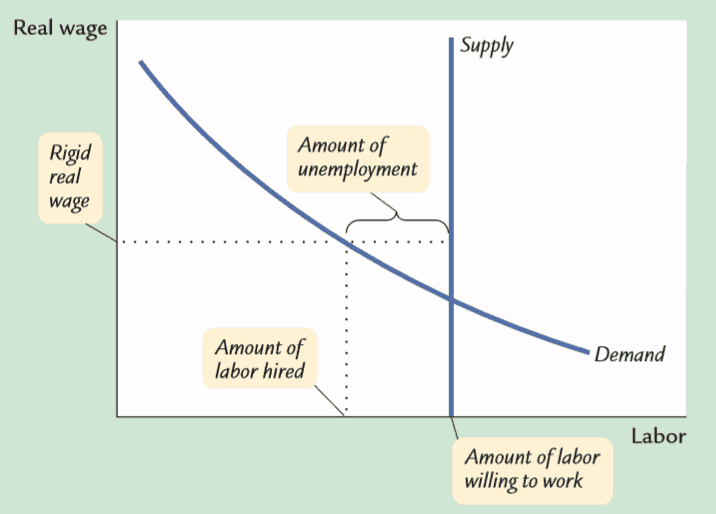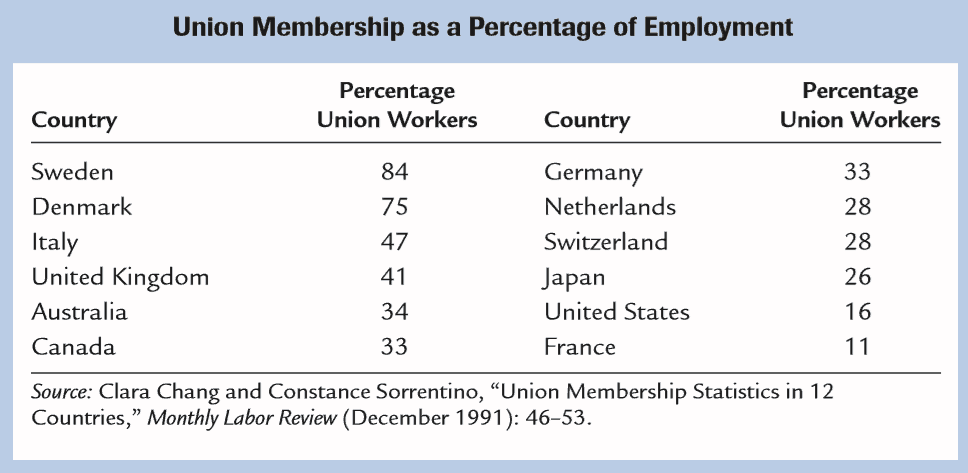Unemployment, when the number of jobs available in the economy is not enough to provide a job for every job seeker, is considered Structural unemployment.
Structural unemployment happens when the wages are above the level that brings supply and demand into stability.

Workers are jobless not because they are eagerly looking for jobs that best suit their expertise.
Instead, at the going wage, the supply of labor exceeds the demand. These workers are merely waiting for jobs to become available.
We will study three probable reasons for an above equilibrium wage. That is minimum-wage laws, unions, and efficiency wages.
Minimum Wage Laws
Minimum wages are not the dominant cause for unemployment in the economy, though it has a significant effect on some groups with usually high unemployment rates.
Furthermore, the analysis of minimum wages is a natural place to start because, as we will see, it can be used to understand some of the other reasons for structural unemployment.
For a majority of workers, this minimum wage is not necessary, because they make well beyond the minimum.
For some workers, particularly unskilled and inexperienced workers, the minimum wage puts their wage above its equilibrium level..
It, therefore, decreases the quantity of their work that firms require.
Economists assume that the minimum wage has its most significant impact on teenage unemployment. The equilibrium earnings of teenagers tend to be low for two reasons.
First, because teenagers are among the least skillful and least experienced workers of the labor force, they usually have low marginal productivity.
2nd, teenagers often take some of their “pay’’ in the form of on-the-job training instead of direct pay. An apprenticeship is a typical example of instruction offered in place of usual salary.
For both these reasons, the salary at which the supply of teenage workers equals the demand is low. The minimum wage is, therefore, more often compulsory for teenagers than for others skilled workers in the labor force.
Unions
A union is a worker association that negotiates with employers over wages and working conditions.

The salaries of union members are not set by the equilibrium of demand & supply instead of joint bargaining between union leaders and companies management.
Unions can also affect the salaries paid by firms whose workforces are not part of the union because the risk of unionization can keep wages higher the equilibrium level.
Unions not only inflate salaries but also raise the bargaining capability of labor on other issues, such as hours of work and working conditions.
A firm may prefer to pay its employees high wages to keep them happy to prevent them from joining a union.
Theory of Efficiency Wages
According to this theory of Efficiency Wages, firms perform better if wages are above the equilibrium level because high salaries make workers more productive.
In that case, it may be beneficial for firms to keep wages high even in the presence of an excess of labor.
Economists have suggested several theories to justify how wages affect workers productivity.
Such as, Better-paid workers can support a healthy lifestyle, and healthier workers are more productive at work.
Also, high wages reduce labor turnover and attract a talented and expert workforce.
Structural unemployment Summary
In all three circumstances, unemployment is the result of wages higher than the level that balances the supply of labor and the amount of workforce required.
Minimum-wage laws and unions prevent firms from lowering wages in the presence of a surplus of workers.
The efficiency wage theory affirms that such pressure on firms is irrelevant in many situations because firms may be better off retaining wages above the equilibrium level.
